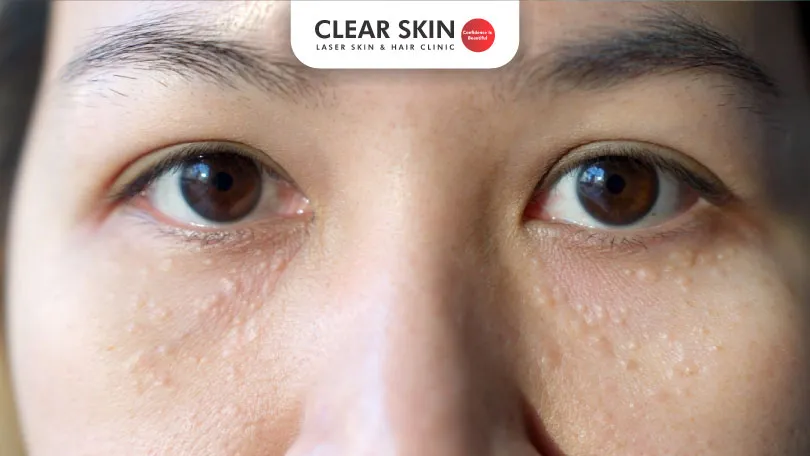Reviewed By:
Category: Milia
Our face is the first thing that anyone sees in us, so if there’s any mark or raised bump we feel embarrassed or might be self-conscious. Milia can be seen in cluster formation over the face. And it affects the individuals only cosmetically. Therefore many people have questions in their minds, “how to get rid of milia” and here I will be explaining how.

Table Of Content
- What are Milia?
- Types of Milia
- What causes Milia?
- How to Remove Milia?
- Treatments for Milia
- How long does Milia removal take to heal?
- How to prevent Milia?
- When to Consult a Dermatologist?
- Conclusion
What are Milia?
If a tiny and painless bump in a group occurs over your nose, cheeks, forehead, jaw, behind ears, and around your eyes, then it might be a Milia. At the surface of the skin when a tiny skin flake gets trapped, then it results in the formation of Milia. Milia is a benign condition, which is completely non-contagious.
Types of Milia
There are various types of milia, such as:
1. Primary Milia (children & adults)
In children, milia are seen over the nasal crease in a row.
2. Traumatic Milia
- Occurs at the site of injury when the skin heals
- Arise from sweat ducts
- Examples include thermal burns, dermabrasion, blistering disorders
3. Milia en plaque
- Multiple milia of various sizes
- Milia found on the eyelids, behind the ear, on a cheek or jaw
- Affects both children & adults, especially middle-aged women
4. Multiple eruptive Milia
Lesions on the face, upper arms, and upper trunk
5. Neonatal Milia
- Doesn’t require treatment
- Affects 40–50% of newborns
- Few to numerous lesions
- The commonest site – is a nose
- Special sites such as the scalp, upper trunk, or inside the mouth -Spontaneously heal within a few weeks of birth
- No treatment required – Reassure the patient’s family
What causes Milia?
Causes of Milia differ in newborns from older children and adults.
Causes of Milia in Newborns
- In the newborn cause, milia are still unknown.
- But many times it can be mistakenly get confused with baby acne.
- Basically caused when the hormones from the mother get triggered.
- Baby acne can only be seen after two to four weeks.
Causes of Milia in Older children & adults
However, in adults and older children, milia are associated with some type of damage to the skin.
- Milia have an association with some other medical skin conditions such as epidermolysis bullosa (EB), cicatricial pemphigoid, or porphyria cutanea tarda (PCT) which results in blistering.
- Burn
- Long-term sun exposure results in sun damage to the skin.
- Long-term steroidal cream use.
- Due to some skin cosmetic treatments, such as dermabrasion or laser resurfacing.
- Aging
How to Remove Milia?
In infants as such no necessary treatment is required, because it will clear up within a week on its own.
Milia can be treated safely and effectively in older children and young adults. An office-hour procedure and has no downtime with no to minimal scarring. However, milia treatment is done only for cosmetic purposes.
Treatments for Milia
1. Cryotherapy
Cryotherapy is one of the commonest methods to remove milia. In conclusion, in cryotherapy use liquid nitrogen to freeze the milia.
2. Deroofing
Deroofing is a treatment in which a sterile needle is used to pick out the contents of the cyst.
3. Topical retinoids
In addition, you can also apply vitamin A-containing creams, so that it will help to exfoliate your skin.
4. Chemical peels
After applying chemical peel where treatment has to be done, it causes the first layer of skin to peel off, i.e it will cause an unearthing of new skin.
5. Laser ablation
Laser ablation is a technique in which a small laser focuses on the affected areas to remove the milia.
6. Diathermy
Diathermy is the technique that helps to destroy the milia with the help of extreme heat.
7. Destruction curettage
In this treatment procedure, milia are surgically scraped and cauterized.
How long does Milia Removal take to heal?
How long does milia removal take to heal? That’s a very common question our milia removal patients ask. The healing process for the removal of milia on the face begins immediately. But the time for complete healing differs from person to person. Typically, it takes at least days for milia removal to completely heal.
Another question patients ask is, is milia contagious? Well. Milia are tiny cysts that develop due to harmless buildups of keratin under the skin. It isn’t contagious or harmful in any way. But it may cause the person to feel self-conscious if the milia are on visible parts of the skin as well.
How to prevent Milia?
However, if your skin is prone to get milia, then as such there’s no way to prevent your skin from getting milia. Therefore I advise you to get your treatment done.
Moreover, many people have a skin tendency to recur milia. If your skin has a tendency to recur milia, then there are possible chances of recurrent milia. However, you will not see any sort of recurrent milia over the treated areas. For more inquiries regarding milia, you can ask us questions, we will try to answer all your possible questions.
When to Consult a Dermatologist?
Conclusion
Popular Q&As
If you’re dealing with black scars on your legs, it’s likely due to conditions like folliculitis caused by ingrown hairs from waxing. Laser hair removal offers a permanent solution by destroying hair follicles, reducing future ingrown hairs. Curious about acne treatment costs in Pune? Learn about laser treatments, session prices, influencing factors, and insurance tips. Do you know what causes pimples on the chest and back? Click to Know more
How to Remove Black Scars on legs?
Unlocking the Secrets of Acne Treatment Costs in Pune: Your Go-To Guide!
Understanding and Managing Chest and Back Acne
We Got Your Back! Ask Us Anything On Your Mind!
Reach out to us on
Didn’t Find What You Were Looking?
Please Contact Us.
We are committed not only to treating you, but also educating you.

